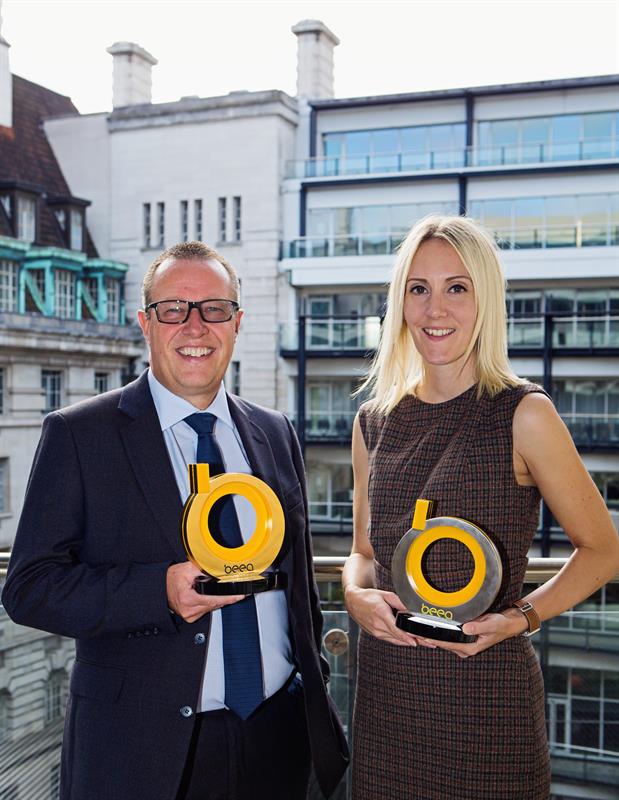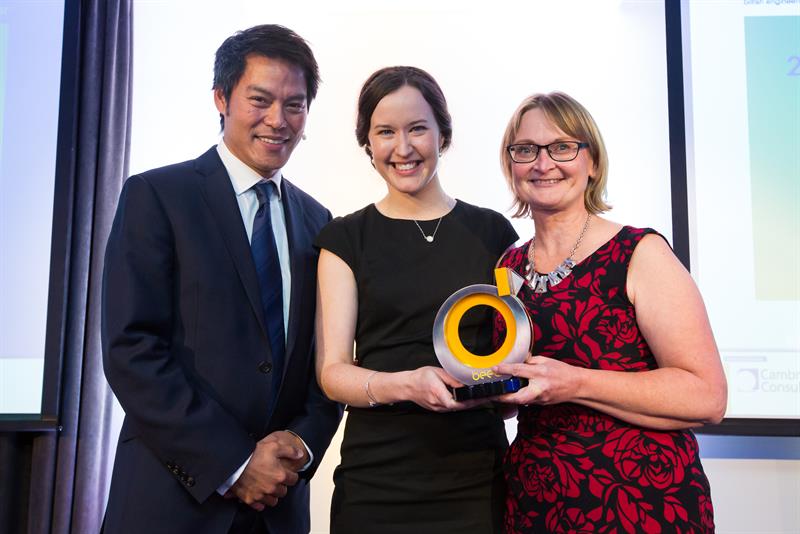When it came to this year’s British Engineering Awards, held in London earlier this month, the question when judging entries was “What have they given back?”
The winner of this year’s Grand Prix, AESSEAL, has – for nearly twenty years – worked tirelessly to help young people see engineering as a possible future career path.
As Winner of the Engineering Ambassador of the Year, AESSEAL duly went on to win the Grand Prix, Best of the Best award, for encouraging increased interest in engineering and promoting the uptake of STEM subjects.
Engineering outreach and engagement is in the company’s DNA and is embedded in its working life at every level.
The first known record of AESSEAL working with students to promote engineering came in 2002, when it sponsored 4,000 sets of 3D CAD software that were made available to local schools, colleges and Sheffield Hallam University as part of the Back to Grass Roots campaign.
Last year the company engaged with 2,250 students, including 190 directly involved in its in-house outreach work with visits to schools and student visits to AESSEAL. This year it has had contact with 2,840 students to date, of which 640 were directly involved in its in-house outreach work.
Its apprentices visit schools to give ‘A day in the life’- type talks to students preparing to make choices about their careers - bringing a career in engineering to life and making it a far more attractive prospect to young people yet to experience the world of work.
AESSEAL also funds four engineering bursaries at Sheffield University, donating £50,000 to the university to support its ‘Engineering Is’ campaign. This looks to create a step change in attracting women into engineering through work with primary schools, funding a physics bridging course for female A-Level students, and supporting female engineering academics to progress into professorial roles.
The AESSEAL Manufacturing Apprenticeship programme in Rotherham was developed in specific response to the engineering skills shortage. It was launched in 2012 in partnership with the University of Sheffield’s Advanced Manufacturing Resource Centre (AMRC) and is run in collaboration with the AMRC and Rotherham College.
The judges said:
“It’s time to recognise the work of a company that, since 2002, has worked with the wider community to promote engineering, reaching out to thousands of potential young engineers.”
Engineering Ambassador of the Year Highly Commended:
TDK-Lambda UK
Consultancy of the Year
Sponsored by: Rutland Plastics
Stirling Dynamics
Taking a highly-collaborative approach to its clients and designs Stirling Dynamics works in the aerospace sector, designing and modifying aircraft and components. Stirling has evolved from being very UK-centric and reliant on one key customer to become an international consultancy servicing multiple customers.
The company follows a “Customer Friendly” business model which is one of its strongest USPs. Stirling is unafraid of sharing IP and knowledge transfer with its customer base. The trusted relationships that it’s built have resulted in repeat business.
The company’s recent success brought it to the attention of Assystem Technologies UK, who acquired Stirling Dynamics in April 2018.
The judges said:
“Delivering a range of complex systems and technical services, the company’s track record of expanding into overseas markets is truly impressive.”
Small Company of the Year
Sponsored by MA Business
Transmission Dynamics
A change of strategy from mechanical to IoT solutions has reaped dividends for Transmission Dynamics.
Established in 1996 as JR Dynamics, since 2006 it has traded as Transmission Dynamics and established itself as a condition monitoring specialist that uses IoT to deliver critical data and reports related to client assets in real time.
By persevering with innovation and creativity, combined with the unique talent, enthusiasm and hardworking of its key staff, TD is now an innovative and fast-growing SMEs in a global market.
This ability to design products from concept to fruition has allowed TD to maintain control over product development right through the product life cycle.
The judges said:
“This was a terrific example of how to take a technology developed in academia, and use it as the basis of a highly successful and flourishing business.”
Highly Commended:
Synergie Environ
Start-Up of the Year
Sponsored by Cambridge Consultants
Circuitworx
Specialising in helping its fellow start-ups bring products to market, Cicuitworx has enjoyed exceptional growth.
Many start-up companies lack the wider technical expertise, systems engineering knowledge or commercial experience to develop their ideas further and this is where CircuitWorx comes in, designing bespoke electronics and software, managing subcontractors and working with the client through the whole product development lifecycle.
This integrated whole-lifecycle engineering design service allows the client to focus on its strengths and wider business objectives being confident in the quality of the technology designed/manufactured by CircuitWorx, resulting in the client’s product being successfully brought to market.
The judges said:
“The company has demonstrated a strong track record, delivering exceptional growth and profitability, based on its ability to provide innovative solutions.”
Design Team of the Year
Sponsored by LG Motion
Imagination Technologies
A team consisting of 90 engineers spread across four countries were able to deliver, in just 14 short months, the PowerVR Series2NX neural networked accelerator (NNA). Delivering high-performance computation of neural networks at very low power consumption in a minimal silicon area, the 2NX was designed from the ground-up to provide hardware acceleration for efficient neural network inference in mobile/embedded platforms.
With flexible bit-depth support on a per-layer basis for weights and data, it can maintain high inference accuracy while drastically reducing bandwidth/power requirements.
It is the only solution supporting bit-depths from 16-bit (required for automotive), to 4-bit, resulting in higher performance at lower bandwidth and power. A single core of 2NX, running at 800MHz, offers up to 2048 MACs/cycle.
The judges said:
“A hard-working team that, despite being geographically dispersed, came together effectively to deliver a complex product in a short amount of time.”

Electronic Product of the Year
Sponsored by TÜV Sud
Xilinx
The data and power demands of 5G networks require a special product to satisfy them.
In response, Xilinx conceived the RF System on Chip (RFSoC) to deliver previously unachieved levels of integration, leveraging its advanced 16nm FinFET process to let analogue functions benefit from the pace of CMOS technology advancement, and so overcome the power and size challenges presented by Massive MIMO.
The key innovation, enabling RF and analogue circuitry to be brought on-chip, is direct RF sampling. This was achieved by Xilinx leveraging its Zynq UltraScale+ MPSoC to provide a proven launchpad. As a result, the RFSoCs monolithically integrate RF data converters and soft-decision Forward Error Correction (SD-FEC) cores are able to meet 5G and DOCSIS 3.1 standards using the 16nm Zynq UltraScale+ MPSoC architecture.
| Above: Grand Prix Winners, ASSEAL. Collecting the award, David Amory, Global Marketing Director and Rebecca Clubbe, Marketing Communications Manager |
As a market-ready product, RFSoC brings together several technical threads, encompassing digital, analogue and RF chip design, as well as soft IP blocks, and device drivers, and customer development tools.
Working with leading infrastructure makers and network operators to ensure RFSoC meets all the needs of 5G stakeholders, Xilinx produced test chips for evaluation in customers’ programmes.
Roll-out was then expanded to 20 customers, in preparation for general availability on the market in 2018.
The judges said:
”This provides a key enabling technology for the future roll-out of 5G. Xilinx has deployed a variety of innovative techniques to overcome a range of technical challenges.”
Young Design Engineer of the Year
Sponsored by RS Components
Brent Brakeboer, Surrey Satellite Technology
The UK satellite industry is no easy place to make your mark, but this year’s winner has done that and more.
In two years Brent Brakeboer had a huge impact on Surrey Satellite Technology having driven the internal development of the next generation of Earth Observation medium resolution wide swath multi band camera systems to replace and upgrade the ageing Rapideye spacecraft system.
Leading the whole design from scratch through to delivery, Brent engaged with subcontractors and suppliers, brought new suppliers into space activities and passed on knowledge of SSTL’s requirements to allow them to improve their designs and expand their businesses into new engineering fields.
Brent’s has de-risked a significant programme for SSTL in advance of the main project and has strengthened the position of the company to provide another world class mission to the market place, bringing tens of millions of pounds of work to the UK space sector.
The judges said of Brent:
”Showing exceptional skills as well as initiative in solving problems, Brent came up with a truly exceptional and differentiated product.”
Highly Commended:
Callum Bramley, Respond
Design Engineer of the Year
Sponsored by Maxon Motor

Orlas Murphy, Jaguar Land Rover
A multi-talented, multi-disciplinary engineer since joining Jaguar Land Rover in 2012, Orla has progressed through different roles in both the Electrical Engineering and Vehicle Engineering departments.
She has worked in the audio team, calibrating the sound systems within the vehicles, using analytical, acoustic and both objective and subjective testing skills.
In the Quality team, she works on complex problem solving for warranty issues. However, over the last year her work in a design role has focussed on a study into Automotive Software Over-the-Air (SOTA), which she led as a joint research project between Jaguar Land Rover and the University of Bradford.
Above: Orla Murphy (centre), Design Engineer of the Year |
Orla has won numerous awards and, as a STEM ambassador, gives technical lectures on her work for all ages, from school children up to retired engineers.
The judges said:
“Orla has come a long way in a relatively short space of time, having progressed through the company in a variety of roles.”
Materials Application
Sponsored by Goodfellow
Nylacast Chock Liner
The Chock Liner by Nylacast is an evolution in mooring technology. Custom manufactured from initial chemistry to end product, the patented Chock Liner delivers safe and reliable moorings by using the advantages of its custom formulated Polyamide 6 material with very low friction properties in order to line the often rough, worn and rusted chocks (or panama fairleads) on vessels.
The judges said:
“A classic example of the right material finding the perfect application to create a successful product.”
Mechanical Product of the Year
Sponsored by Minitec
Aeristech
Aeristech has invented a new motor control technology, Aeristech Control Technology, ACT making possible a variable speed electric motor more power dense than any other in the world.
To suit the needs of fuel cells it developed an air compressor, FCC, superior in every respect to any other in the market.
Supported by an “Advanced Propulsion Centre” and an “EU Horizon 20/20 grant” for re-engineering the device for mass production and developing a bill of quantities, the launch of the Aeristech FCC supplying a 120kW+ fuel Cell powering a vehicle demonstrator is scheduled for summer 2019.
The judges said:
”Aeristech impressed with its response to a real market need and is set for real commercial success.”













